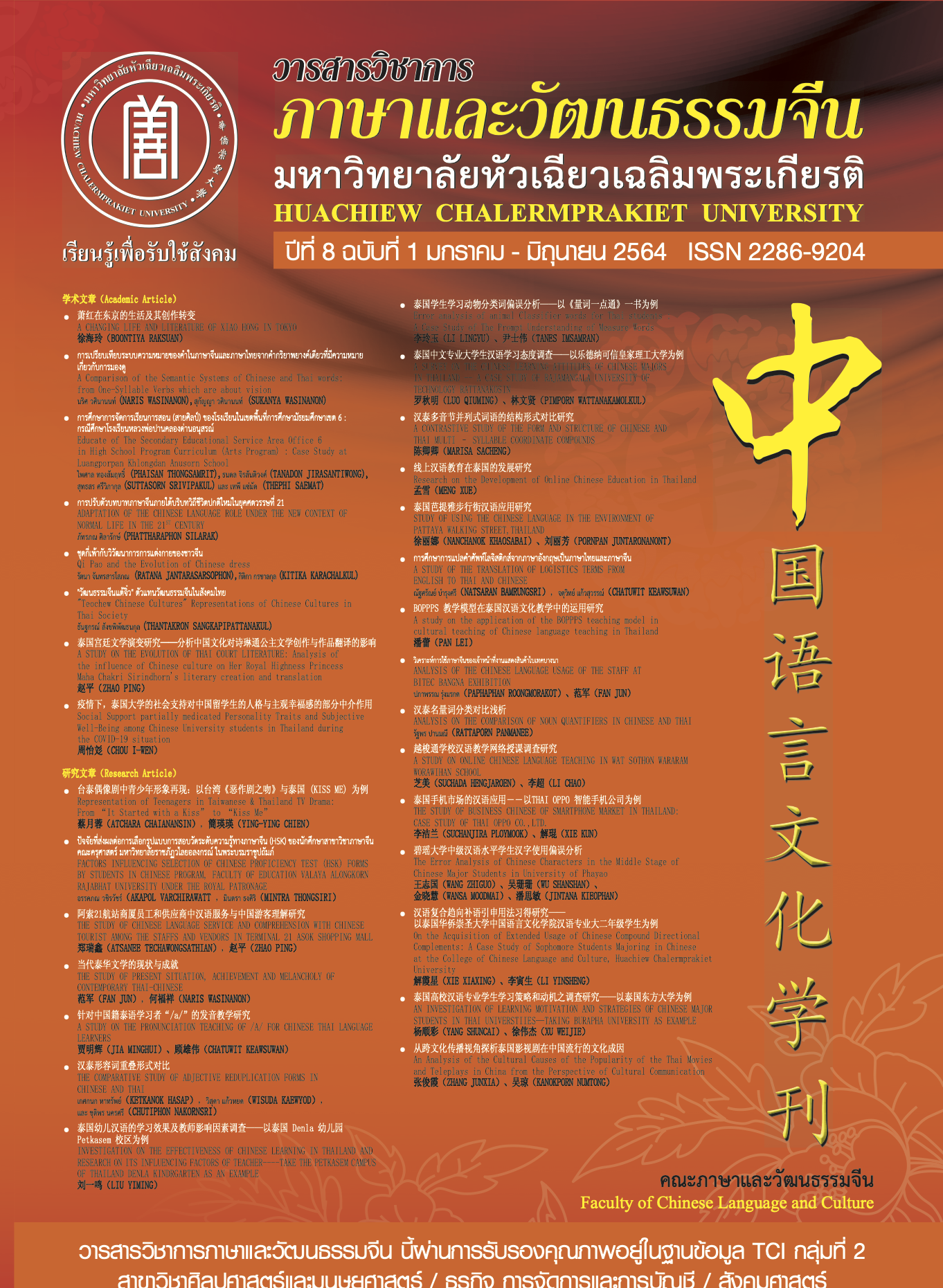A Study on the Evolution of Thai Court Literature: Analysis of the influence of Chinese culture on Her Royal Highness Princess Maha Chakri Sirindhorn's literary creation and translation
Keywords:
The evolution of Thai court literature, Royal Highness Princess Maha Chakri Sirindhorn, Chinese culture, Literary creation, Translated literatureAbstract
ABSTRACT
In the long history of Thai literature from ancient literature to modern and contemporary literature, Thai literature has undergone a series of evolutions. The court literature, with court literati as the main creative group of ancient literature, gradually lost the dominant position of Thai literature in modern literature. It quietly withdrew from the Thai literary scene and replaced it with popular literature. Folk writers began to dominate Thai literature.
The thesis analyzes the influence of Chinese culture on Her Royal Highness Princess Maha Chakri
Sirindhorn's literary creation and translation of literary works through the study of the development and changes of Thai literature. The thesis takes the evolution of Thai literary genre and subject matter, the evolution of prose travel notes and the evolution of translation of Chinese literary works as the main research objects. It outlines the context of the development of Thai literature, explains the historical background of the development of Thai literature and analyzes the reasons for the evolution of court literature.
With the development of history, Thai court literary writers as a whole group of writers gradually withdrew from the Thai literary world. A large number of modern Thai literary works began to come from the hands of folk writers, while literary works from the court are rare. However, the literary creation of court writers did not stop completely. In the 1980s, Her Royal Highness Princess Maha Chakri Sirindhorn, the daughter of King IX of Bangkok became the representative of contemporary court writers and the main literary writer from the court. Under the influence of Chinese culture, Her Royal Highness Princess Maha Chakri Sirindhorn not only wrote many prose travel notes, but also translated many modern and contemporary Chinese literary works. Her Royal Highness Princess Maha Chakri Sirindhorn became the promoter of cultural exchanges between China and Thailand, the promoter of the integration of Chinese and Thai literature, and the messenger of friendly exchanges between the people of China and Thailand.
References
栾文华.泰国文学史[M].社会科学文献出版社,1998
王晓新.中国古典小说的翻译对泰国文学发展的影响[D].北京语言文化大学2002
雷华.论中国古代文学对泰国文学的影响[J]. 四川师范学院,东南亚纵横2002(06)
]侯营.中国古典文学对泰国文学的影响[J].广西师范大学,华文文学2007(4)
韦春萍.论翻译对泰国古代文学史的影响[J].考试周刊,2011
搜狐网:暨佩娟: 传播中国文化的使者,人民网曼谷2013-3-28。http://roll.sohu.com/20130329/n370829480.shtml [2020-5-12]
文通网:泰国诗琳通公主翻译铁凝小说《永远有多远》首发。
https://china.huanqiu.com/article/9CaKrnJEMqR [2020-6-13]
百度百科:游记,https://baike.baidu.com/item/%E6%B8%B8%E8%AE%B0/3748614?fr=aladdin [2020-6-23]
景宁新闻网:际政坛掀起汉语热 各国政要竞相"秀"中文
http://jnnews.zjol.com.cn/jnnews/system/2011/04/21/013636658_01.shtml
维基百科:诗琳通公主御作列表,https://zh.wikipedia.org/wiki/%E8%AF%97%E7%90%B3%E9%80%9A%E5%85%AC%E4%B8%BB%E5%BE%A1%E4%BD%9C%E5%88%97%E8%A1%A8 [2020-6-18]
维基百科:《采桃花》,https://zh.wikipedia.org/wiki/%E6%8E%A1%E6%A1%83%E8%8A%B1 [2020-6-16]
维基百科:《长城游》,https://zh.wikipedia.org/wiki/%E9%95%B7%E5%9F%8E%E9%81%8A
-6-16]
维基百科:诗琳通公主御作列表https://zh.wikipedia.org/wiki/%E8%AF%97%E7%90%B3%E9%80%9A%E5%85%AC%E4%B8%BB%E5%BE%A1%E4%BD%9C%E5%88%97%E8%A1%A8 [2020-6-11]
凤凰网:长江日报.泰国公主的“中国情缘”.
https://book.ifeng.com/gundong/detail_2013_04/10/24040638_0.sh [2013-4-10],
Bilibili网站: https://www.bilibili.com/read/cv2813015?from=search [2020-6-3]
泸江泰语:诗琳通公主学汉语.汉泰杂志,https://th.hujiang.com/new/p438454/
-6-14]
Downloads
Published
How to Cite
Issue
Section
License
บทความที่ได้รับการตีพิมพ์เป็นลิขสิทธิ์ของวารสารภาษาและวัฒนธรรมจีน มหาวิทยาลัยหัวเฉียวเฉลิมพระเกียรติ
บทความใน “วารสารวิชาการภาษาและวัฒนธรรมจีน” เป็นทรรศนะของผู้เขียนโดยเฉพาะ กองบรรณาธิการไม่มีส่วนในความคิดเห็นในข้อเขียนเหล่านั้น




